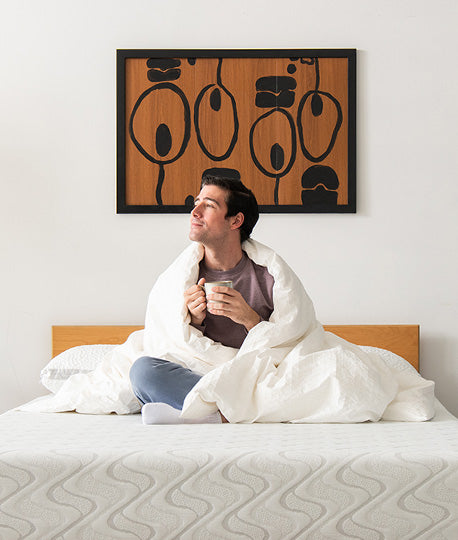Breathe Better to Sleep Better: How Your Lungs Help You Sleep


You probably already know that many people suffer from insomnia and other sleep-related difficulties. In fact, a full 10% of people in the West have problems with chronic insomnia. When you add all the individuals who have sleep apnea, the number goes up.
It's also true that most people do not get enough carbon dioxide to the brain during sleep because of improper breathing. In fact, health professionals say the way you breathe can affect your entire body. When you breathe properly throughout the day, you receive the proper amount of oxygen and carbon dioxide, thus allowing for a restful sleep. If you experience a stressful day with times of shallow breathing or mild hyperventilating, then your quality and quantity of sleep will be affected.
Yet, not everyone knows they can breathe better to sleep better.
Many people don't think much about their breathing because it's something we do automatically. However, as we learn to breathe properly throughout the day, it will aid us in our sleep at night.
How Breathing Works
To understand better how breathing affects us, we need to take a closer look at the breathing process. There are two main muscles involved in respiration:
- Diaphragm muscle
- Intercostal muscle
As you inhale, the diaphragm, which is located just below the ribs, contracts. When this happens, it pushes the rib cage upward on the ends and downward in the middle. It expands the thoracic cavity allowing air to enter and fill up the lungs. The intercostal muscle comes into play when you exhale. As you exhale, your intercostal muscles, which are between your ribs, relax. That reduces the space in your chest area as you expel the air out of your windpipe. The cycle starts over again as you take in another breath using your diaphragm muscles.
Accessory muscles are another set of muscles that are sometimes used in breathing. However, these muscles are only used to assist in the breathing process usually when there is a problem. These muscles are not supposed to be primary players. That's why they are called accessory. When the diaphragm and intercostal muscles are not doing an adequate job breathing, then the accessory muscles step in to help. However, the accessory muscles are supposed to be only called upon when there is an underlying problem such as:
- Asthma
- Pneumonia
- Chronic obstructive pulmonary disease (COPD)
- Extreme stress situations (fight or flight reaction)
The problem is that many times people are using their accessory muscles, which are in the neck, to perform much of their breathing.
What Happens When You Breathe Incorrectly
You may wonder since breathing is automatic, why would people practice incorrect breathing, especially if it's going to interrupt their sleep and result in physical problems. While breathing may be automatic, there are other automatic responses too that may override proper breathing.
For example, if you were driving down the road and a small animal darted in front of you and you nearly missed it, your automatic response may be to hit the brakes or swerve. Of course, we know doing so could cause a worse accident but we don't think at the moment. We just respond automatically. Your heart rate would probably accelerate and your muscles tense up, and although you may not recognize it, your breathing would change. Your accessory muscles would take over most likely due to the stress of the situation. All of this would occur within seconds without you so much as thinking much about it. You would probably just be thinking about how glad you were you didn't hit the animal.
It is just one example of how accessory muscles can participate in breathing and thus result in faulty breathing techniques. Situations like this happen regularly throughout most of our lives. We live in a highly stressful, fast-paced world. Other lifestyle situations that trigger the accessory muscles for regular breathing include:
- Poor posture
- A faulty mattress not supporting the body
- Hunching over a steering wheel in traffic too long
- Dealing with ongoing chronic pain
When we continually breathe the wrong way using the wrong muscles, we inadvertently strain muscles in the neck, shoulder, and back area. This results in some of the following conditions:
- Chronic neck pain
- Breath holding
- Frequent sighing or lack of getting a deep breath
- Poor sleep
- Digestive complaints
- Feeling tightness and tension in the chest, neck, and throat
- Chronic back pain
Test Your Breathing Method at Home
You are probably wondering by now if you are breathing correctly. Let's try a test to see whether you are currently using your diaphragm to breathe.
- Place your hands on your bottom ribs or on your solar plexus.
- Take a breath while keeping your hand in place.
- Answer the following question: Which region moves first? Does the chest lift first or does the stomach expands out? If your chest is pushing up first, then you are not breathing from your diaphragm.
How to Breathe Better to Sleep Better
Fixing your breathing is possible. However, if you try too hard to focus on it, you may start breathing irregularly (remember the flight or fight stress breathing). Here are some simple ways to improve your breathing and thus sleep better, which will help you feel better.
- Be aware of faulty breathing. As you go about your day, be mindful of situations that cause tension. Check your breathing at those moments and make a conscious effort to breathe deeply and slowly from the diaphragm.
- Be sure you have an ergonomic chair if you sit often for work.
- Take time during the day, if you sit a lot, to stand and stretch to release the tension from your body.
- Check your mattress out to make sure that it is adequate to provide restful sleep. You aren't just looking for signs of wear and tear, although that's certainly important, you need to make sure you have a mattress that gives your body the support it needs throughout the night. Some people do best with a firm mattress, while others need a medium firm mattress. If you have back problems, you will want to use a pillow to elevate your knees slightly to ease the pressure from your back.





